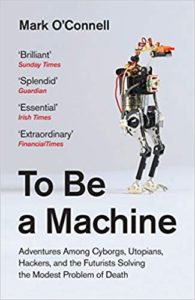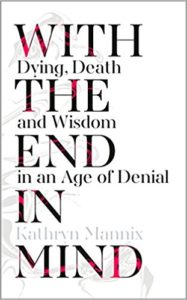Mark O’Connell’s “To Be a Machine”
 Religion, more or less, arises out of divine wreckage. And science, too — religion’s estranged half sibling — addresses itself to such animal dissatisfactions. In The Human Condition, writing in the wake of the Soviet launch of the first space satellite, Hannah Arendt reflected on the resulting sense of euphoria about escaping what one newspaper report called “men’s imprisonment to the earth.” This same yearning for escape, she wrote, manifested itself in the attempt to create superior humans from laboratory manipulations of germ plasm, to extend natural life spans far beyond their current limits. “This future man,” she wrote, “whom the scientists tell us they will produce in no more than a hundred years, seems to be possessed by a rebellion against human existence as it has been given, a free gift from nowhere ( secularly speaking), which he wishes to exchange, as it were, for something he has made himself.”
Religion, more or less, arises out of divine wreckage. And science, too — religion’s estranged half sibling — addresses itself to such animal dissatisfactions. In The Human Condition, writing in the wake of the Soviet launch of the first space satellite, Hannah Arendt reflected on the resulting sense of euphoria about escaping what one newspaper report called “men’s imprisonment to the earth.” This same yearning for escape, she wrote, manifested itself in the attempt to create superior humans from laboratory manipulations of germ plasm, to extend natural life spans far beyond their current limits. “This future man,” she wrote, “whom the scientists tell us they will produce in no more than a hundred years, seems to be possessed by a rebellion against human existence as it has been given, a free gift from nowhere ( secularly speaking), which he wishes to exchange, as it were, for something he has made himself.”
A rebellion against human existence as it has been given: this is as good a way as any of attempting to encapsulate what follows, to characterize what motivates the people I came to know in the writing of this book. These people, by and large, identify with a movement known as transhumanism, a movement predicated on the conviction that we can and should use technology to control the future evolution of our species. It is their belief that we can and should use technology to augment our bodies and our minds; that we can and should eradicate aging as a cause of our death; that we can and should use technology to augment our bodies and our minds; that we can and should merge with machines, remaking ourselves, finally, in the image of our own higher ideals. They wish to exchange the gift, these people, for something better, something man-made. ( p.2)
….
In philosophy of mind, the notion that the brain is essentially a system for the processing of information, and that in this it therefore resembles a computer, is known as computationalism. As an idea, it predates the digital era. In his 1655 work De Corpore, for instance, Thomas Hobbes wrote, “By reasoning, I understand computation. And to compute is to collect the sum of many things added together at the same time, or to know the remainder when one thing has been taken from another. To reason therefore is the same as to add or subtract.”
And there has always been a kind of feedback loop between the idea of the mind as a machine, and the idea of machines with minds. “I believe by the end of the century,” wrote Alan Turing in 1950, “one will be able to speak of machines thinking without expecting to be contradicted.”
As machines have grown in sophistication, and as artificial intelligence has come to occupy the imaginations of increasing numbers of computer scientists, the idea that the functions of the human mind might be stimulated by computer algorithms has gained more and more momentum. In 2013, the EU invested over a billion euros of public funding in a venture called the Human Brain Project. The project, based in Switzerland and directed by the neuroscientist Henry Markram was set up to create a working model of a human brain and, within ten years, to simulate it on a supercomputer using artificial neural networks.
( p.55-56)
Wellcome Book Prize 2018 winner Mark O’Connell’s To Be a Machine: Adventures Among Cyborgs, Utopians, Hackers, and the Futurists Solving the Modest Problem of Death is an incredible account of the journalist’s investigation into what is transhumanism and who are these people actively engaged in this movement, in their search for the Holy Grail of longevity with the help of technology. It is an astonishing book for the amount of research involved, the innumerable meetings, the conferences attended, ideas shared, all of which are pretty amazing given that money is being poured into researching this niche area of how the human life span can be increased. It it is the underlying, very human, deep fear of death that is propelling this research forward with entrepreneurs like Peter Thiel also involved in funding these activities. There are famous centres like the centre maintained by the Alcor Life Extension Foundation which is experimenting with cryogenics in keeping humans “alive”.
In this interview with The Irish Times, Mark O’Connell says “Transhumanism really is for me the displacement of yearnings and anxieties that have traditionally been the preserve of religion. But, overwhelmingly, that’s a sore point for transhumanists. They see themselves as the heirs to enlightenment. In their kind of hyper-rationalist thinking, any notion of spiritualism or mysticism is a complete anathema.”
In another interview with The Verge he says “When you talk to transhumanists, in one way or another, they all aspire to knowing everything and to being gods basically. And I just sort of thought, this is actually something I can’t relate to at all. The idea of being that all-powerful and omnipresent, it’s almost indistinguishable from not existing and I can’t quite justify that.
They’d say, you’ve got Stockholm syndrome of the human body. But that kind of idea is very unappealing to me. I can’t see why that would be your idea of your ultimate human value. I was always trying to come to grips with these ideas and come to grips with what it meant for these people to be post-human, and just wind up getting more confused about what it meant to be a human at all in the first place. I can identify with wanting to not die, but I can’t with wanting to live indefinitely.”
It is a surreal world that the transhumanists believe in, with almost an evangelical fervour for defeating mortality. The reason Mark O’Connell embarked upon this quest of his was because he had become a father for the first time and suddenly questions of mortality and death became very real. ( On a related note. Here is a superb article in The Paris Review of Mothers as Makers of Death by Claudia Dey, 14 August 2018.) But he is very clear, even after one a half years of research for this book, that he will never be a cyborg or a transhumanist. A fact he reiterates in the book as well as in an interview to The Millions. His deep dive in to the subject makes him an expert in the field so he recommended five books to understand transhumanism for The Guardian too (10 May 2018).
Whether you agree or not with the transhumanists, To Be a Machine must be read to understand how man is pushing the known boundaries of knowledge using technology to try and find an answer to the eternal question “How to overcome mortality?”. It is like reading science fiction except that all that is written in the book is very real — very real people, very real experiments in very real facilities. For now it may seem like a fanciful playground of a bunch of well-funded individuals ( mostly male) who may or may not find their Holy Grail, but a possible offshoot of this innovative research may have other more practical applications. Who knows?! Only time will tell.
To buy the book published by Granta on Amazon India:
17 August 2018

